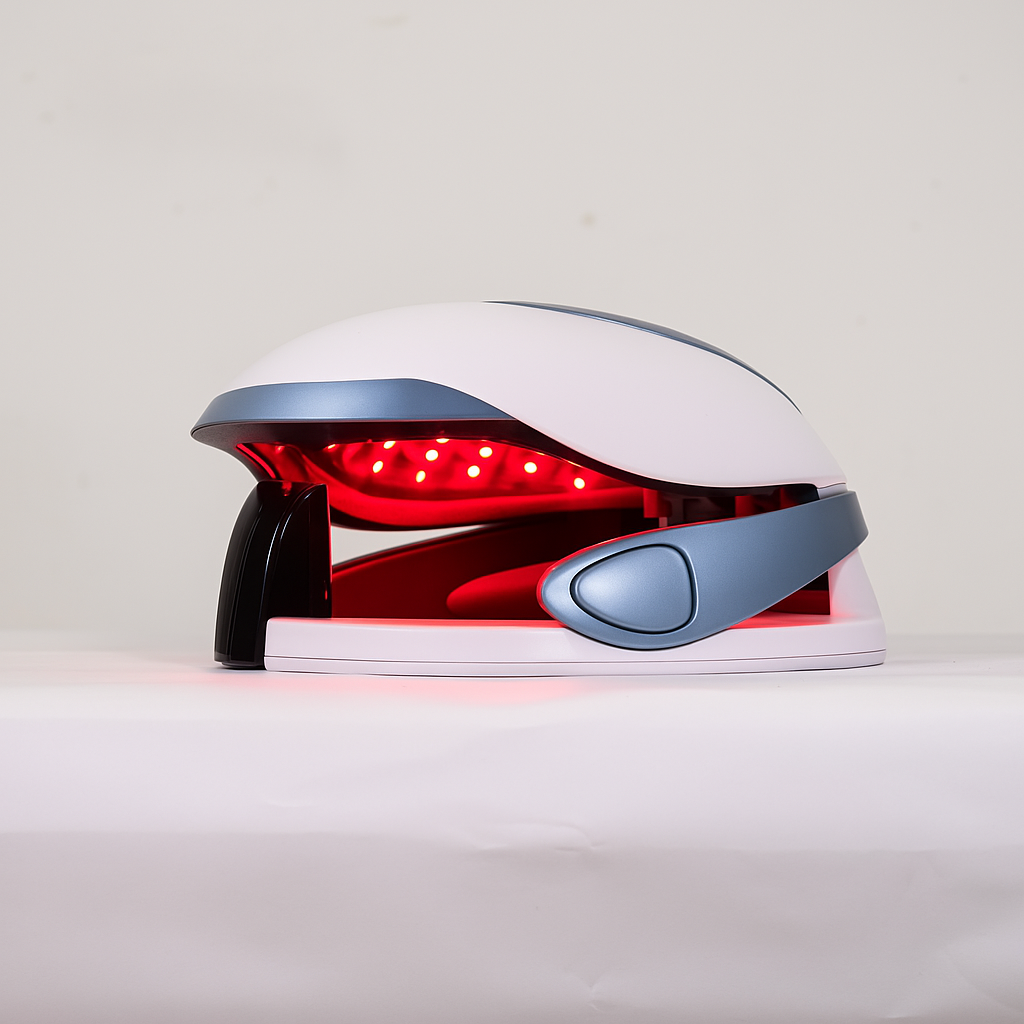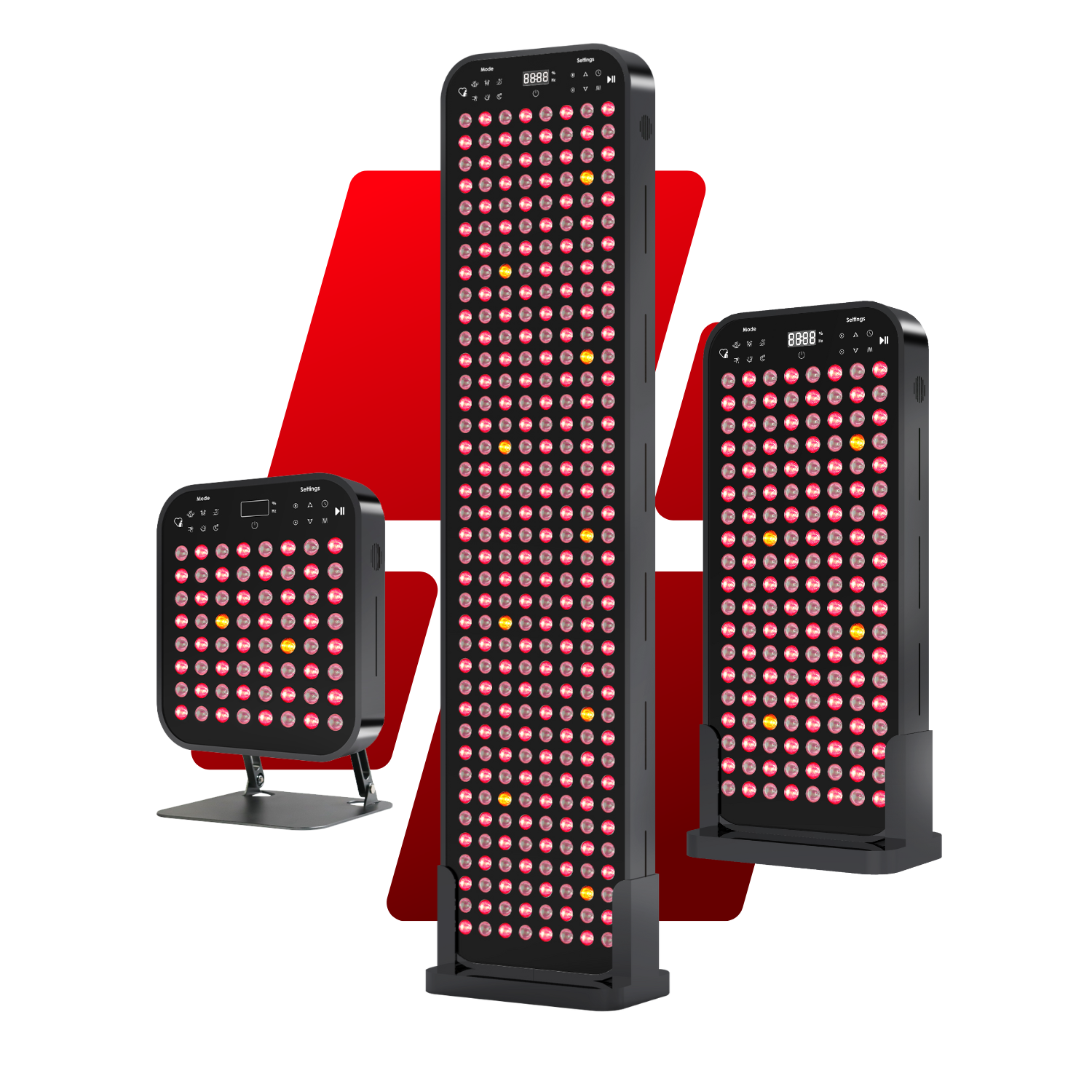
Red Light Works for Hair Loss
- and Dermatologists Have Known for Years
When people imagine high-tech hair loss treatments, they probably picture expensive prescriptions, scary side effects, or some futuristic transplant procedure that costs more than a used car. What they probably don’t picture? Sitting on the couch wearing a glowing, sci-fi-looking helmet that quietly zaps their scalp with light.
And yet… here we are in 2025.
If you’ve spent any time on social media or searching “why is my hairline betraying me,” you’ve probably come across something called Red Light Therapy (or its slightly fancier cousin, Near Infrared Light). What used to be a clinical, in-office treatment is now available at home — thanks to wearable LED and laser devices that look like they came straight out of a Marvel movie prop bin.
But don’t let the glowing lights fool you.
This isn’t gimmicky wellness fluff. Red Light Therapy is rooted in real science, originally developed by NASA to help astronauts heal faster in space. In dermatology, red and near-infrared light have been used for years to treat skin aging, inflammation, and muscle recovery — and now, research shows it can also stimulate hair follicles and support regrowth.
Most dermatologists have been quietly watching this trend for years — and now they’re recommending it more often, especially when it comes in the form of FDA-cleared, laser-equipped helmets. Are the claims real? Does it actually work? And can sitting under a glowing dome for 20 minutes a day actually bring back your hairline?
We’re diving into the science, the skepticism, and what it really takes to grow thicker, fuller hair — with tools that are finally catching up to the promise.
What is light therapy (for hair)?
In short, light therapy is a non-invasive treatment that’s been studied for over 30 years. When it comes to hair, it typically involves exposing the scalp to red light using LEDs and laser diodes. These specific wavelengths are absorbed by the skin and hair follicles, triggering biological processes that can help with hair regrowth, circulation, and inflammation reduction.
What does it do for hair?
When used consistently, red light therapy (often called low-level light therapy, or LLLT) has been shown to help stimulate hair follicles, extend the growth phase (anagen) of the hair cycle, and increase blood flow to the scalp. Translation: it helps create the ideal environment for healthier, stronger hair to grow — especially in people dealing with thinning, shedding, or early-stage pattern hair loss. Even if you’re not experiencing significant hair loss, red light therapy may support scalp health and improve hair density and thickness over time.
-

Patient 1
Over a 6 month period
-
Patient 2
Over a 8 month period
-
Patient 3
Over a 6 month period
And the benefits go more than scalp-deep. Red light therapy isn’t just about hair — it’s also been linked to improved mood, reduced stress, and even better sleep. Many users report that just a few minutes under a red light device helps them feel calmer, more energized, and noticeably less frazzled. Need a scientific reason? Red and near-infrared light help boost ATP production (that’s your cells’ energy currency) and can support serotonin regulation, which may explain the subtle mood lift people feel with consistent use.
Since the benefits — both cosmetic and mental — are cumulative, consistency is key. Regular sessions are what get real results. But let’s be honest: booking clinic visits two or three times a week isn’t exactly realistic for most people. That’s where at-home red light therapy helmets come in — offering professional-level technology you can use from the comfort of your couch (bad hair day approved).
Curious which devices actually deliver? We’ve got thoughts — and tested a few ourselves. Let’s dive in.

BEST IN TRIALS - THE ARTEMIS LED CROWN
This futuristic Red Light device looks like it has laurels on the side. It has clinical studies conducted for Androgenic Alopecia in Korean medical centers posted on PubMed with their exact device which is a rarity in the hair loss space.
It hails from Korea, the beauty capital of the world. Most notably 1 out of 5 Koreans suffers from Androgenic hair loss which is why this product was developed.
Pros: Can use by gender and Norwood-Hamilton & Ludwig-Savin Classification, easy to use, fast results
Cons: It's expensive, has a wired remote but all devices like this do.

BEST RLT PANELS - RedMD
These sleek panels are the definition of light on command (literally). Engineered with professionals in mind first but are accessible to at home users as well. Tackling everything from hair treatment, facial care, and the whole body. The voice commands make you feel like you're living in the future.
They offer 5 different pro panels depending on your use case.
Pros: Easy to use, voice commands, adjustable, touch screens/tap settings, variety of uses cases. The Pro Plus series also offers blue light therapy for acne and customized clinical settings.
Cons: Pricey, can be a bit awkward for hair treatment unless laying down, the larger units can be heavy but that speaks to their quality and sturdiness.
WHICH IS BEST FOR YOU?
Like many things in this world, it's situational. In fact it's NONE industry wide if you are sensitive to light or take any medications that increase light sensitivity.
That aside, if you can afford the best from clinical trials then go for the Artemis LED Crown
If that feels like too much of a splurge, we can't blame you—there are other devices and caps on the market. Just know, they typically lack the peer-reviewed clinical trials and the cutting-edge precision that Korean beauty tech is known for.
Otherwise, panels like the RedMD has to offer provides a good blanket strategy for tackling not only hair loss but skincare, muscle recovery, anti-aging, and overall wellness.

ABOUT THE AUTHOR:
Outside of work and conferences, there's nothing more that I enjoy than Yoga or a glass of wine. Sometimes together.
- Kathryn Shaffer



